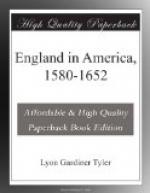Shortly after Argall’s visit John Smith sailed, in 1614, for the northern coast, with two ships fitted out by some private adventurers. While the ships were taking a freight of fish, Smith, with a view to colonization, ranged the neighboring coast, collecting furs from the natives, taking notes of the shores and the islands, and making soundings of the water. Smith drew a map of the country, and was the first to call it “New England” instead of North Virginia, Norumbega, or Canada. This map he submitted to Prince Charles, who gave names to some thirty points on the coast. Only Plymouth, Charles River, and Cape Ann have permanently kept the names thus fastened upon them. Boston, Hull, Cambridge, and some others were subsequently adopted, but applied to localities different from those to which Prince Charles affixed them.
While he was absent one day Thomas Hunt, master of one of his vessels, kidnapped twenty-four savages, and, setting sail, carried them to Spain, where he sold most of them. The outrage soured the Indians in New England, but of the captives, one, named Squanto or Tisquantum, was carried to England, and his later friendliness worked to the benefit of subsequent English colonization.[1]
In 1615 Captain Smith entered into the service of the Plymouth Company and was complimented with the title of “Admiral of New England.” With great difficulty they provided two ships and despatched them to effect a settlement, but the result was the old story of misfortune. The ship in which Smith sailed was captured by the French, and Smith himself was detained in captivity for some time. Captain Dormer, with the other vessel, proceeded on his voyage to New England, but did not attempt anything beyond securing a cargo of furs.
Smith tried to stir up interest in another expedition, and travelled about England in 1616, distributing his maps and other writings, but he says “all availed no more than to hew rocks with oyster-shells.” Smith’s connection with the American coast then ceased altogether; but his plans of colonization were not without fruit, since his literary works, making known the advantages of New England, kept the attention of the public fastened upon that region.[2]
At this time the most prominent member of the Plymouth Company was Sir Ferdinando Gorges, son of Edward Gorges, of Worcestershire, born about 1566. He served at Sluys in 1587, was knighted by Essex before Rouen, in October, 1591, and in 1593 was made governor of the port of Plymouth in England, which office he still held. Despite the ill-fortune attending past efforts, he continued to send out vessels under color of fishing and trade, which ranged the coast of New England and brought news of a calamity to the natives unexpectedly favorable to future colonization. In 1616-1617 the country from Penobscot River to Narragansett Bay was almost left “void of inhabitants” by a pestilence which swept away entire villages of Indians. This information, together with the better knowledge due to Gorges of the value of the fisheries, caused a revival of interest regarding New England among the members of the Plymouth Company.[3]




